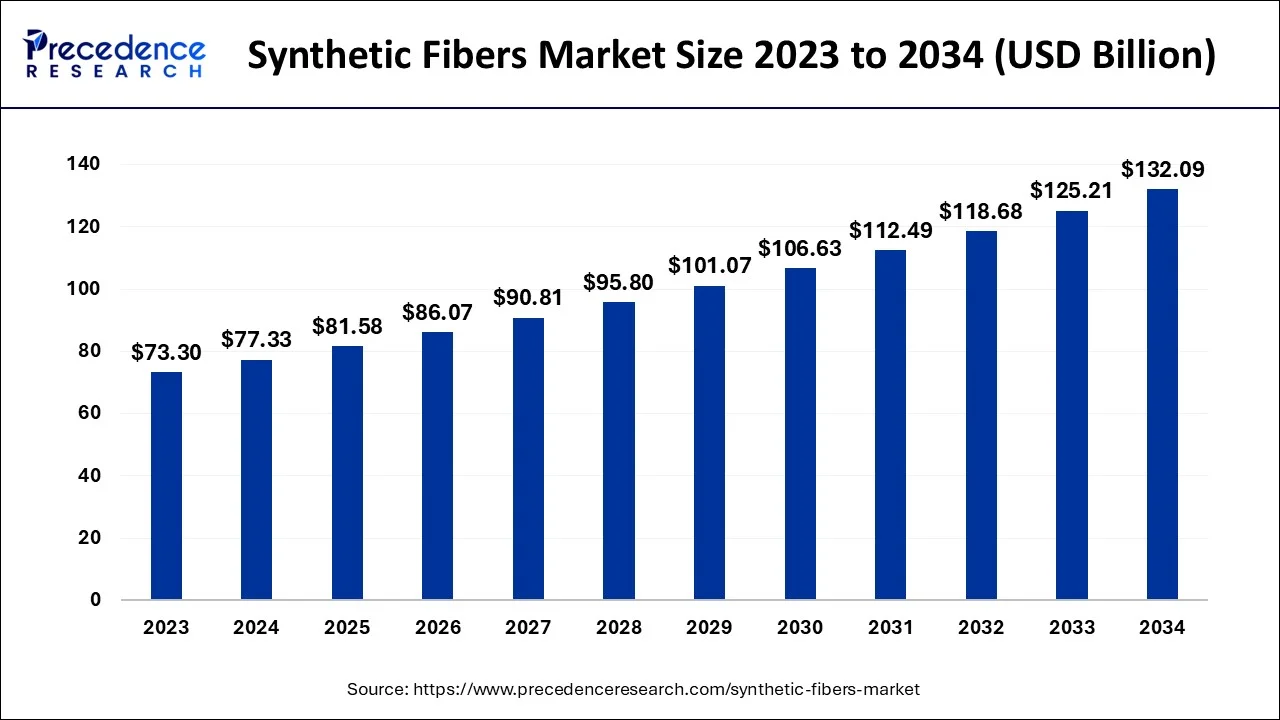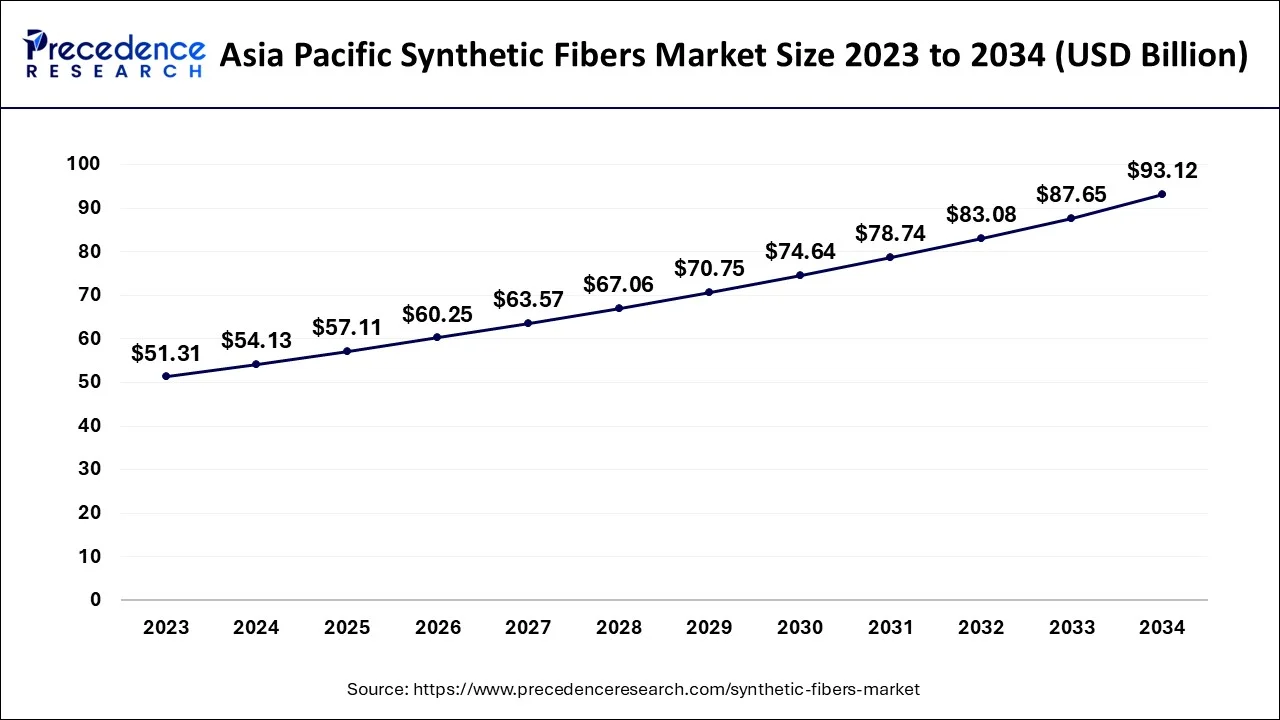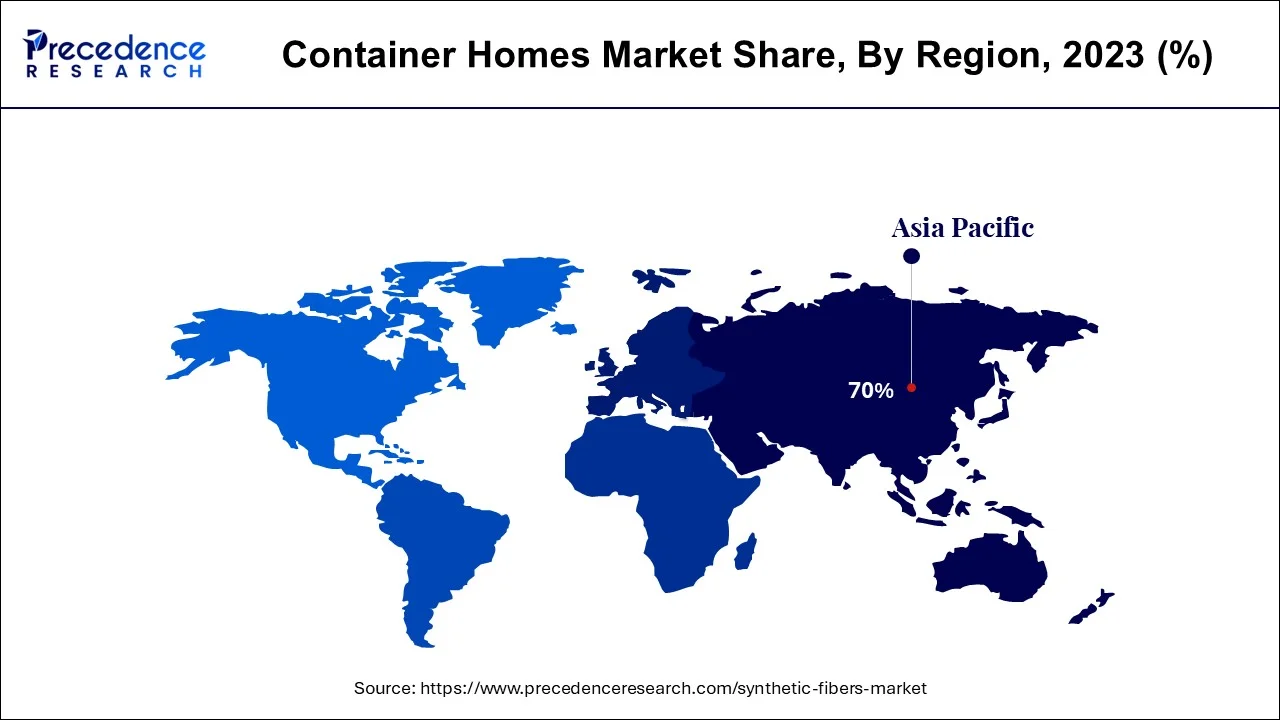List of Contents
Synthetic Fibers Market Size and Forecast 2024 to 2034
The global synthetic fibers market size is estimated at USD 77.33 billion in 2024 and is anticipated to reach around USD 132.09 billion by 2034, expanding at a CAGR of 5.50% from 2024 to 2034.

Synthetic Fibers Market Key Takeaways
- In 2023, Asia Pacific contributes the highest share around 70%.
- By application, the clothing segment contributed the highest share around 48%.
- By product, the polyester product segment constituted a revenue share of 49% in 2023.
- In terms of volume, the Europe synthetic fibers market was valued at over 5,420 kilotons in 2023.
Asia Pacific Synthetic Fibers Market Size and Growth 2024 to 2034
The Asia Pacific synthetic fibers market size is estimated at USD 54.13 billion in 2024 and is expected to be worth around USD 93.12 billion by 2034, rising at a CAGR of 5.57% from 2024 to 2034.

Asia Pacific captured a market share of around 70% and dominated the global synthetic fibers market in 2023. Asia Pacific is the leading producer of acrylics, polyester, and nylon, and these are extensively produced in the nations such as India, China, Japan, South Korea, and Taiwan. Asia Pacific is one of the largest consumers of textile clothing and the major markets are China and India. Rapid industrialization and rapid urbanization are expected to foster the demand for various products made from synthetic fibers and hence the Asia Pacific is expected to be the fastest-growing market throughout the forecast period.

Rising demand for home furnishing products in Europe and significantly growing demand for automotive vehicles in the region is expected to boost the demand for various products like seat covers, seat belts, blankets, and bed covers. Hence, Europe is expected to witness considerable growth during the forecast period.
Surging demand for clothing and rise in technological advancement in textile production and growing investments in the expansion of cloth manufacturing facilities in Central and South America are expected to boost the growth of the synthetic fibers market during the forecast period.
Synthetic Fibers Market Growth Factors
Synthetic fibers are man-made fibers manufactured using petrochemicals. It is known for its superior chemical and physical properties like elasticity, durability, and strength. The low cost, and water and stain-resistant properties of synthetic fibers are the major factors behind their rising demand across the globe. The rising applications of synthetic fibers in the textile, industrial, indoor, outdoor, and commercial sector has propelled the growth of the global synthetic fibers market. The various common and special synthetic fibers include acrylic, polyester, nylon, carbon fiber, spandex, and rayon. Surging demand for the durable, cost-effective, and easy-to-wash fabrics among global consumers is significantly driving the growth of the global synthetic fibers market. The growing demand for synthetic fibers in home furnishing, automotive, clothing, and filtration is expected to boost the growth of the synthetic fibers market during the forecast period.
The constantly changing fashion trends, rise in e-commerce, and growing demand for home furnishing products in developed markets like North America and Europe are expected to be the major growth drivers of the synthetic fibers market. Rising technological advancements in production methods have led to the development of superior mechanical, chemical, and physical characteristics of synthetic fiber that are not only used in textiles but also extensively used in electronics, food packaging, water purification, air filters, aerospace, and healthcare sectors. This is a major driver of the global synthetic fibers market. Rapid industrialization, rapid urbanization, increasing disposable income of consumers, and changing consumer behavior for textiles is positively impacting the growth of the synthetic fibers market across the globe.
However, environmental concerns like the non-integrability of synthetic fibers may hamper the growth of the market in the forthcoming future. The rising focus on achieving sustainability, especially in developed economies is boosting the demand for natural and organic alternatives to synthetic fibers. Therefore, the rising concerns regarding environmental health may decrease the demand for synthetic fibers in the forthcoming years.
Market Scope
| Report Coverage | Details |
| Market Size in 2024 | USD 77.33 Billion |
| Market Size by 2034 | USD 132.09 Billion |
| Growth Rate from 2024 to 2034 | CAGR of 5.50% |
| Largest Market | Asia Pacific |
| Fastest Growing Market | North America |
| Base Year | 2023 |
| Forecast Period | 2024 to 2034 |
| Segments Covered |
|
| Regions Covered |
|
Product Insights
Depending on the product, the polyester product was the dominating segment in the global synthetic fibers market that accounted for a market share of around 49% in 2023. The major attraction for the consumers of polyester is the abrasion and chemical resistance properties of the polyester. This feature has significantly contributed to the growth of the polyester segment in the global synthetic fibers market. Polyester is extensively used in cloth manufacturing owing to its wrinkle-free, shape retention, high perspiration, and easy wash properties. The significantly growing global textile industry is expected to boost the growth of the polyester segment during the forecast period. The surging demand for polyester in home furnishing and industrial applications is expected to spur the growth of the segment. The use of polyester in industries in the form of ropes and yarns has exponentially favored market growth.
On the other hand, the nylon product segment is anticipated to be the most opportunistic segment during the forecast period. The significantly rising applications of nylon material in the home furnishing and automotive industry is augmenting the demand for nylon products across the globe. The demand for various home furnishings products such as bed linen, carpets, blankets, and upholstery is rising owing to the rising number of homes and a growing number of nuclear families across the globe. The rising global population across the globe is expected to boost the growth of the segment during the forecast period.
Application Insights
Based on the application, the clothing segment garnered a market share of around 48% and dominated the global synthetic fibers market in 2023.The continuously changing fashion and clothing trends across the globe and surging demand for cost-effective, convenient, and protective clothing have significantly contributed to the growth of the clothing segment. The huge presence of numerous clothing brands and the need to serve the different needs of consumers is boosting the growth of the clothing segment. Furthermore, the surging penetration of e-commerce platforms across the globe and rising consumer awareness regarding various clothing brands due to the rising access to the internet has boosted the demand for clothes thereby driving the growth of the clothing segment.
Home furnishing is expected to be the fastest-growing segment during the forecast period. The rising real-estate and housing sectors are significantly driving the growth of the home furnishing sector. The rising number of houses, the growing population, and the rising number of nuclear families are boosting the demand for the home furnishing products like cushions, mats, bed covers, and soon.
Synthetic Fibers Market Companies
- Bombay Dyeing
- Toyobo Co., Ltd.
- E. I. du Pont de Nemours and Company
- Toray Chemical Korea, Inc.
- Reliance Industries Ltd.
- Indorama Corp.
- Teijin Ltd.
- Lenzing AG
- China Petroleum Corp. (Sinopec Corp.)
- Mitsubishi Chemical Holdings Corp.
Key Market Developments
- In April 2019, Raymond Group, introduced its Ecovera, an eco-friendly range of fabrics manufactured by using one of the latest technologies of the Reliance Industries Limited.
- In November 2019, Technical Absorbents displayed its washable fabrics at the Premier Event for Absorbent Hygiene & Personal Care Markets in Texas.
- The market is moderately fragmented with the presence of several domestic and global market players. These market players are constantly engaged in various developmental activities like partnerships, mergers, acquisitions, and new product launches to gain a competitive edge over others and gain market share. The rising investments by these market players in research and development are expected to open up new opportunities in the foreseeable future.
Segments Covered in the Report
By Product
- Nylon
- Polyester
- Polyolefins
- Acrylics
- Others
By Application
- Automotive
- Clothing
- Home Furnishing
- Filtration
- Others
By Geography
- North America
- Europe
- Asia-Pacific
- Latin America
- Middle East & Africa (MEA)
For inquiries regarding discounts, bulk purchases, or customization requests, please contact us at sales@precedenceresearch.com
Frequently Asked Questions
Ask For Sample
No cookie-cutter, only authentic analysis – take the 1st step to become a Precedence Research client